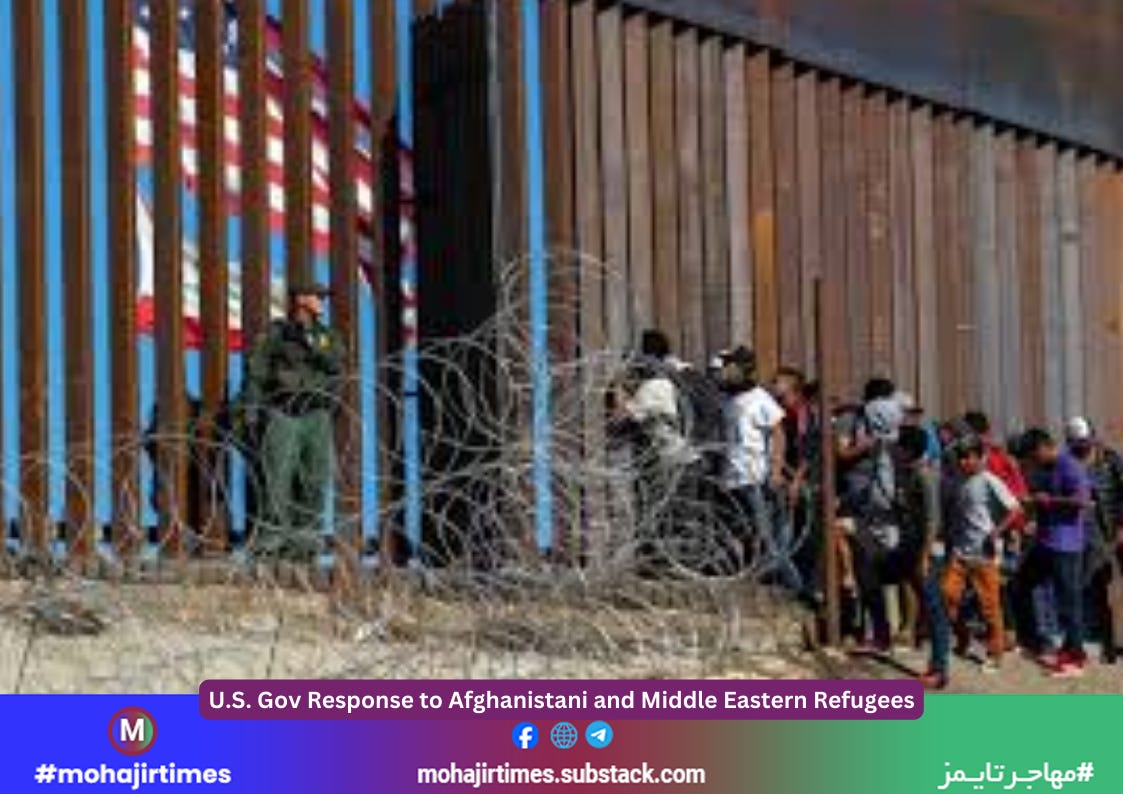U.S. Gov Response to Afghanistani and Middle Eastern Refugees
The integration of refugees into American society remains a challenge, with issues such as employment, housing, and healthcare often exacerbating the difficulties newly arrived individuals face
By: Asadullah Jafari (Pezhman)
Introduction
The issue of refugees, particularly those from Afghanistan and the Middle Eastern, has emerged as a significant humanitarian concern worldwide. Over the past two decades, ongoing conflicts, political instability, and economic hardships have forced millions to flee their home countries in search of safety and stability. The United States, as one of the world's largest recipients of refugees, has been at the forefront of addressing the needs of these individuals. Afghan refugees, especially those displaced due to the fall of the Afghanistan government and the rise of the Taliban in 2021, as well as refugees from Middle Eastern countries experiencing conflict, such as Syria and Iraq, have sought refuge in the U.S. However, the challenges of integrating these refugees into American society while maintaining national security have raised complex political, social, and ethical questions. This paper explores how the U.S. government has responded to the refugee crisis, the role of various levels of government in addressing this issue, and the effectiveness of these responses.
United Nations High Commissioner for Refugees (UNHCR)
The refugee crisis involving individuals from Afghanistan and other Middle Eastern countries has become a pressing issue, especially in the aftermath of the U.S. withdrawal from Afghanistan in August 2021. The rapid takeover of Afghanistan by the Taliban forced millions to flee, seeking refuge in neighboring countries and beyond. Despite the daunting challenges, these resilient individuals have shown remarkable strength and determination, inspiring hope in the face of adversity. According to the United Nations High Commissioner for Refugees (UNHCR) (2021), as of 2021, over 2.6 million Afghan refugees have been registered worldwide, with a significant portion resettling in the U.S. Refugees from Syria, Iraq, and other Middle Eastern nations facing prolonged conflicts have similarly sought asylum in the U.S., creating significant demographic and social changes.
These refugees face numerous challenges, including legal hurdles to obtaining asylum, economic struggles, cultural integration difficulties, and mental health issues due to the trauma experienced in their home countries. However, despite these challenges, the presence of refugees also brings cultural diversity and economic contributions, which have often been overlooked in public debates about immigration. Furthermore, the influx of refugees raises concerns about security, public services, and the strain on local resources in areas with high refugee populations. The issue affects not only the refugees themselves but also the communities where they resettle, particularly in cities like New York, Houston, and Los Angeles, where large refugee communities have emerged.
In the U.S. federal system, which level of government (local, state, or national) or branch (executive, legislative, or judicial) is responsible for addressing the issue?
In the U.S. federal system, the responsibility for addressing the refugee crisis lies primarily with the federal government, involving multiple branches: the executive, legislative, and judicial. The executive branch, led by the President and the Department of Homeland Security (DHS), plays a significant role in determining refugee admissions and overseeing asylum procedures. The U.S. Citizenship and Immigration Services (USCIS), under the DHS, processes asylum applications and resettles refugees. The President can issue executive orders related to refugee policies, such as adjusting the annual refugee cap or introducing temporary protections like the Temporary Protected Status (TPS) granted to certain Afghan nationals following the U.S. withdrawal (Biden, 2021).
The legislative branch, specifically the U.S. Congress, has the power to create and amend immigration laws that govern refugee resettlement. According to the Immigration and Nationality Act of 1965 and subsequent laws, Congress sets the quotas and criteria for refugee admissions, ensuring that these policies align with the U.S.'s international commitments under the Refugee Convention. Upholding these commitments is not just a legal obligation but a moral responsibility that reflects the U.S.'s global leadership in addressing humanitarian issues. However, Congress has often been divided on how many refugees should be admitted, reflecting political disagreements on immigration (Pelosi, 2021).
The judicial branch plays a critical role by interpreting refugee laws, such as ruling on the constitutionality of executive orders related to refugee admissions and ensuring that asylum seekers' due process rights are upheld. U.S. courts have consistently reinforced the principle of non-refoulement, prohibiting the deportation of refugees to countries where they may face persecution (Supreme Court, 2021).
Identify all of the government officials discussed in your sources. Include their names and the level of government and agency the officials represent.
1. Joe Biden: President, Federal, Executive Branch
2. Alejandro Mayorkas: Secretary, U.S. Department of Homeland Security (DHS), Federal, Executive Branch
3. Kamala Harris: Vice President, Federal, Executive Branch
4. Nancy Pelosi: Speaker, U.S. House of Representatives, Federal, Legislative Branch
5. Greg Abbott: Governor, Texas, State, Executive Branch
How have these government officials attempted to address the issue?
The actions of U.S. government officials have ranged from humanitarian efforts to policy enforcement. Joe Biden, upon assuming office, took immediate steps to address the situation of Afghan refugees after the Taliban's takeover. In addition to issuing executive orders that reinstated refugee resettlement programs, Biden pushed for the Afghan Refugee Resettlement Act, which aimed to expedite the process of granting visas and asylum to Afghan nationals who worked with U.S. forces during the 20-year conflict (Biden, 2021). The Biden administration also provided emergency humanitarian aid to refugees fleeing Afghanistan and other Middle Eastern conflict zones.
Alejandro Mayorkas, Secretary of the Department of Homeland Security, has been pivotal in managing the U.S. refugee system, including efforts to increase the efficiency of the refugee vetting process. Under Mayorkas' leadership, the Biden administration expanded the number of refugees admitted annually, focusing on Afghan refugees. Mayorkas also introduced measures to ensure that Afghan refugees were given safe passage to the U.S., even amid the chaos surrounding the fall of Kabul (Mayorkas, 2021).
As Vice President, Kamala Harris has led efforts to address the root causes of migration from Central America and Afghanistan. Harris visited countries like Guatemala and Mexico to improve regional cooperation and economic conditions while also focusing on building partnerships with international organizations to assist Afghan refugees displaced by conflict (Harris, 2021). Harris's role emphasized the importance of addressing the symptoms and causes of displacement.
Nancy Pelosi, Speaker of the House, advocated for increasing the number of refugees accepted into the U.S. and pushed for the Dream and Promise Act to protect refugees and immigrants from deportation. She has been a vocal proponent of comprehensive immigration reform, which includes provisions for refugees fleeing violence and persecution in the Middle East and Afghanistan (Pelosi, 2021).
Greg Abbott, Governor of Texas, has taken a more restrictive approach, mainly when dealing with refugees and asylum seekers. Abbott has used state resources to bolster border security and has taken legal actions to challenge federal policies on refugee resettlement. While his policies focus on enforcement, Abbott has also supported programs to assist refugees already in Texas, such as providing legal aid and community support services (Abbott, 2021).
Has the government done a good job addressing the issue? Why or why not? What more should be done, and by which level of government?
The U.S. government has made significant strides in addressing the refugee crisis, particularly in providing refuge to Afghan and Middle Eastern refugees. The Biden administration's actions, such as facilitating the swift evacuation of Afghan nationals and expanding refugee quotas, represent a commitment to humanitarian values. However, the response has been far from perfect. The chaotic withdrawal from Afghanistan highlighted the gaps in preparedness and the limitations of the U.S. refugee system. Many refugees, particularly those fleeing Afghanistan, faced delays in processing, creating undue hardship. The integration of refugees into American society remains a challenge, with issues such as employment, housing, and healthcare often exacerbating the difficulties newly arrived individuals face.
More can be done to streamline the refugee application process, ensure better coordination between federal and state governments, and provide more support for integration programs. Both the federal and state governments have crucial roles to play. The federal government should continue to work with international organizations to provide humanitarian aid and expedite resettlement. In contrast, state governments should focus on providing resources for refugee integration at the local level, including access to education, mental health services, and employment opportunities.
Conclusion
In conclusion, the U.S. government's response to Afghan and Middle Eastern refugees has been marked by both successes and challenges. While federal efforts to provide humanitarian aid and expedite resettlement have been significant, integrating refugees into American society remains a complex issue. The federal and state governments must continue collaborating and refining policies to ensure that refugees receive the support they need while balancing national security concerns. With ongoing global conflicts, the role of the U.S. in providing refuge to those fleeing persecution will remain an important issue in the years to come.





